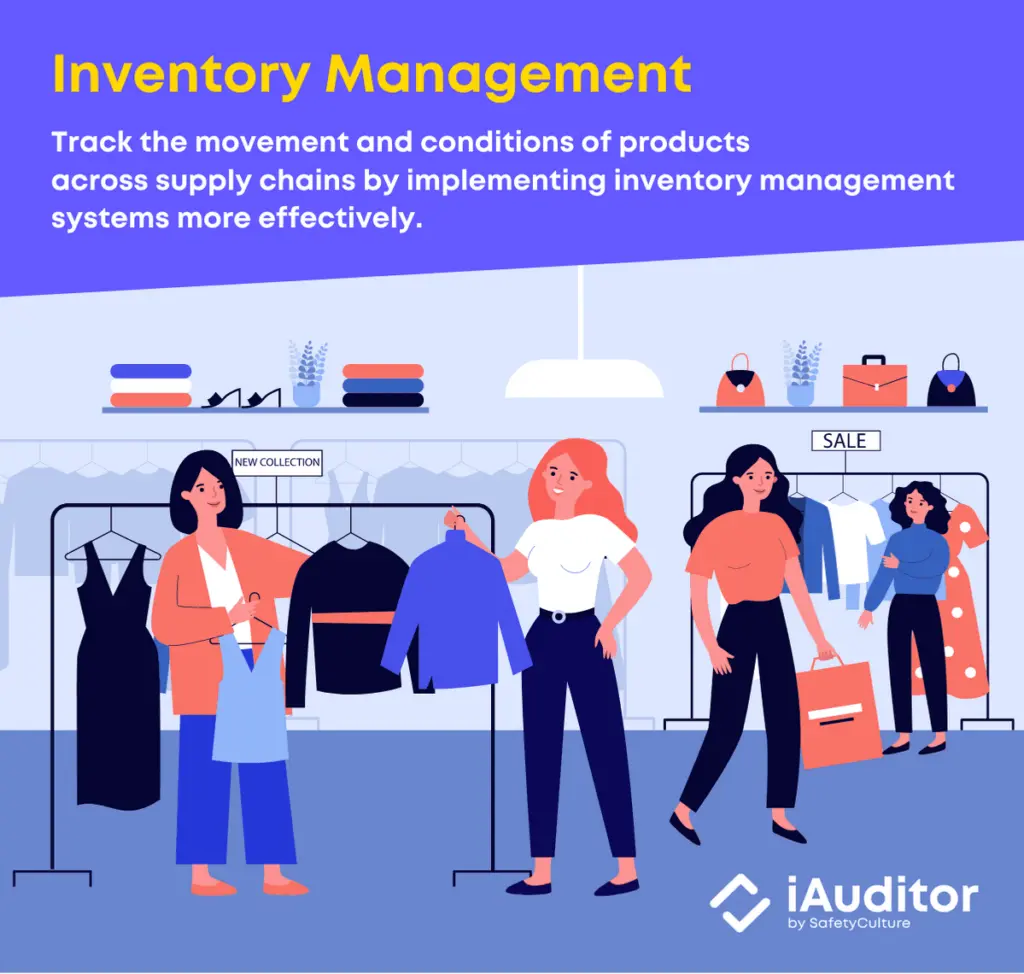What is Inventory Management?
Inventory management is a system primarily used in the retail industry to track the movement of raw materials and finished goods. It also involves monitoring the conditions of components and products as they move in the supply chain. Inventory management aims to align stock levels across the business and streamline workflows from sourcing, storing, and selling.
Inventory Management Process
There are two prevalent inventory management techniques used by many: Enterprise Resource Planning (ERP) and Materials Requirement Planning (MRP). Generally, however, the inventory management process entails data collection and record-keeping of inventory-related elements in typical retail operations. From storefronts to suppliers, an end-to-end retail inventory management process normally includes these 5 steps:

Step #1: Regularly Use Inventory Checklists
It all starts with a checklist. Inventory checklists are used to itemize stocks of merchandise, goods, properties, or building materials and record if the list of supplies and purchases corroborate with the actual number of products on hand.
There are different kinds of inventory checklists depending on scope and type. For example, raw materials, work-in-process, and finished goods inventory checklists are more commonly used in production and packaging.
In retail inventory management, a general checklist is used to itemize stocks with their label, quantity, and net value. With this checklist, retail sales clerks can take photos of inventory and automatically attach them in a report. It can also be confirmed that products have been checked by placing their digital signature, and with a tap of a finger, instantly send the inventory list to designated personnel.
Step #2: Conduct Retail Store Audits
Effective inventory management processes have solid store-level procedures in place. With scheduled and surprise retail audits, store managers can efficiently control and monitor the status, branding processes, and standardization of retail procedures, especially in keeping track of product inventory.
One of the fastest ways to enforce an effective process for inventory management is to regularly conduct retail store audits. Use this checklist as a general guide to ensure that not only the store layout, window display, and facilities meet set standards, but also the products, point of sale materials, and storage are all set in proper order. A checklist can also help ensure that wastes are eliminated from processes effectively.
The inventory management process in retail usually covers auditing visual merchandising practices. Proper visual merchandising in retail stores can help in managing inventory more effectively. Audit reports offer a more comprehensive view of inventory, allowing staff to easily corroborate stocks across stores.
Utilize this visual merchandising checklist to evaluate a store’s exterior and interior, shelves, in-store promotions, and employees.
To continuously improve the effectiveness of existing inventory management methods, consider implementing mystery shopper activities. Retail mystery shopping can help employers receive feedback from the customer’s perspective and look into the normal, day-to-day operations of a retail store, including how they manage inventory.
This retail mystery shopping checklist comes with inspection items relating to inventory—the path to purchase.
Step #3: Schedule Product Inventory Inspections
Product inventory should not only be displayed and priced correctly but also all accounted for, especially in terms of quality. In retail inventory management processes, regular visual inspections of components and products help maintain the quality—and quantity—of product inventory. In field service management, inventory management serves as a key component. Regular inventory inspections helps control and manage spare parts, tools, and equipment required for completing a service.
Managing inventory can be made easier when they are already verified for accuracy upon receiving them. Ensure that a specific shipment aligns with purchase order specifications with this incoming inspection checklist. Inspect incoming inventory for their color, shape and markings, label them as accepted, conditionally accepted or rejected, and indicate whether or not there are major or minor defects.
High-quality packaging is a significant part of taking care of product inventory. Use this checklist to help reinforce inventory management that safeguards products through packaging quality control. Mark the packaging for materials as acceptable, defective, or hold and take the appropriate course of action to solve inconsistencies from the onset.
Doing random checks for inventory quality can be helpful in determining how effective the current management system is. Moreover, empowering workers to regularly check inventory quality can not only help in detecting signs of potential discrepancies, it can also save time and effort in validating inventory lists. This digital check sheet can be used on any mobile device and can also include best practice reference images to assist with inspections.
Step #4: Inspect Inventory Storage Facilities
Inspecting storage facilities whether in-store premises or at warehouses and distribution centers can help in making it easier for personnel to authenticate quantities of stocks. Cleanliness, orderliness, and safety of inventory storage plays a vital role in reinforcing an inventory management process onsite.
Inventory management doesn’t only encompass areas where components and products are being sold, but also, where they’re being stored. Use this checklist to conduct a quick walkthrough of inventory storage facilities, and complete a professional report with pre- and post-inspection photos. Properly stored inventory can be easier to check for coherence with inventory lists.
During these times, an inventory management process with safety protocols has definitely become one of retailers’ top priorities, especially for those involved in international trade.
The safe storage of goods is also crucial to effectively manage inventory, and this checklist can help employees do just that. By detecting potential storage rack damage, on-the-ground personnel can better protect the condition of products and prevent wasting valuable inventory.
Understandably, one of the most difficult products to inventory is food because of its limited shelf life, especially for perishable goods in the retail food and service industry.
Utilize this safe food storage procedures checklist to ensure the safe storage of food inventory, whether through dry storage, refrigerated storage, and/or freezer storage. Check out SafetyCulture (formerly iAuditor)’s temperature and humidity sensors to monitor conditions in real-time and be alerted when things go out of range.
Conduct Inspections of Inventory Storage Facilities
See how efficient inventory inspections can be.
Download SafetyCultureStep #5: Audit Vendors and Suppliers
From inventory lists and retail stores to product quality and storage conditions, the inventory management process comes full circle by also auditing the suppliers of raw materials and finished goods, or also known as a supplier audit.
Sourcing components and products is critical in implementing effective inventory management because it serves as the starting point for most business models. Retailers can stay on top of inventory management tasks when they can consistently get the numbers right starting from their sources.
This supplier audit checklist generally covers the top 5 elements of supplier suitability for providing what you’re looking for—management responsibility, fundamentals, food safety and HACCP systems, manufacturing quality systems, and regulatory consideration.
Even though this checklist contains more than 15 sections of specific audit criteria, it is certainly worthwhile to evaluate current and potential suppliers, vendors, and manufacturers of the goods you trade. It can be easier for retailers to manage inventory when they get their source right and continuously improve their procurement processes.
Ethically sourced products from suppliers can help implement an effective inventory management approach because it sets up businesses for long-term success. Having confidence in the performance of suppliers, especially in terms of labor standards, health and safety, the environment, and business ethics, enables retailers not only to gain a good reputation but also avoid costly litigation.
Use this supplier ethical trade audit checklist to assess current, or even potential, vendors against the SMETA four key pillars.
Types of Inventory System
While inventory systems come in various forms with different functions, it is generally accepted that there are two major systems for managing inventory: periodic and perpetual. The main difference between the periodic inventory system and the perpetual inventory system is how often inventory data gets updated—the former periodically updates inventory, while the latter updates inventory data in real-time. This makes the former ideal for inventory management methods like First In, First Out (FIFO).
SafetyCulture as Inventory Management System
With a globalized economy and the ever-increasing growth of international trade, maximizing and monitoring product inventory is a make-or-break situation for retailers. Any inconsistency or deficiency can cause unnecessary delays, negatively affecting day-to-day processes and customer satisfaction.
Gain unprecedented visibility of business operations using the SafetyCulture Inventory Management Software. With a holistic approach to inventory management, retailers can streamline inventory-related tasks and more—from creating inventory lists to validating raw materials, works in progress, and finished goods; from inspecting product inventory and their storage conditions to verifying the performance of retail suppliers.
Advantages of Inventory Management with SafetyCulture
Taking advantage of the SafetyCulture digital and mobile-first platform can help raise your inventory management game. Catering to various company goals, team sizes, and tech budgets, listed below are top 3 advantages of implementing inventory management with SafetyCulture:
Ease of Use
Managing inventory on a regular basis is already a challenge in itself, so adding systemic complications is the last thing that frontline teams will ever need.
Our inventory management system is easy-to-use enough that employers can seamlessly deploy it across sites and employees will want to use it every day. SafetyCulture offers adequate functionality that workers need to make it easier for them to do their jobs efficiently.
Flexibility
Transitioning from paper-based inventory lists to digital inventory checks or moving from one inventory management system to another causes procedural changes, especially during implementation.
We understand how it can take time to establish the new and improved way of managing inventory, so it is essential for us to develop an inventory management system that is responsive to different user needs and system requirements.
Cost-effectiveness
One of the biggest enablers—and sometimes, hindrances—to enforce an effective inventory management system in a company is resource allocation.
Retailers need to make time to look into the baseline features they need for operating productively and set aside appropriate budgets for investing in systems that can especially benefit the organization for long-term success.
Claim your 30-day free trial of SafetyCulture premium and see if we’re the best inventory management system for you.




